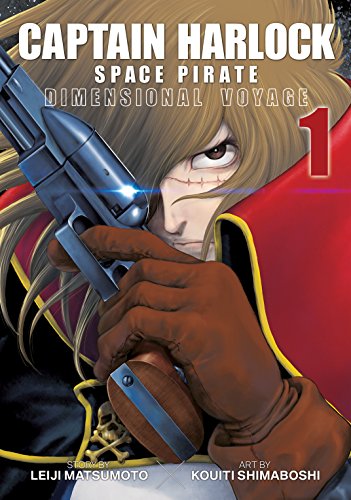By Leiji Matsumoto and Kouiti Shimaboshi. Released in Japan as “Captain Harlock – Jigen Koukai” by Akita Shoten, serialization ongoing in the magazine Champion Red. Released in North America by Seven Seas. Translated by Zack Davisson.
When I’d heard that Seven Seas had licensed this 21st century Harlock reboot, I said that if they really wanted to impress folks they would go get the original manga from the 70s – which they proceeded to do, and that should be out in 2018 or so. That said, that doesn’t make this any less interesting. I’m not sure how much input Matsumoto actually had on the finished project, but it certainly feels just like it should. It’s a retelling of the original series, featuring Harlock’s fight to protect what he values most, as well as picking up a new crewmember whose father was killed. We see an Earth that has fallen, if not into ruin, then at least into disrepair, as the only people who gave a damn have long since left for space, leaving behind the corrupt and uncaring, mostly. And, of course, we have the florid dialogue, which may be the chief highlight.
I haven’t yet read the original, so I’m not sure how much of this is just a straight up remake of the original and how much is updated content. I did like the beginning of the story, which seems to be framed by a sympathetic reporter as she interviews people about what they think of Harlock. This not only shows off the varied and different opinions that they have, and introduces a large majority of the cast, but it also lulls us into thinking that she may be the viewpoint character – nope, it’s a fakeout. But quite well done, and reminds us that the enemies we’re facing here are the Mazon, a race of female humanoids who seek to destroy Harlock. They’re not getting very far in that regard. After this we meet the actual viewpoint character, Tadashi Daiba, who may look familiar to anyone who’s seen a Matsumoto manga – diverse character types is not his specialty, thought Tadashi does at least manage to be taller than some of the others we’ve seen.
I’d previously reviewed the two volumes of Queen Emeraldas, and noted that it felt like reading a manga adaptation of a Wagner opera. There’s some similarity here, but it also definitely has the feeling of a 21st century work, rather than something from two generations ago. I’d say this is more of an Andrew Lloyd Webber musical, with big gestures and dramatic confrontations galore. Every like is declaimed rather than spoken, as if each of the characters knows that they are part of an ongoing lyrical poem that will only end in destruction. This is not to say that this is 100% depressing – Harlock’s crew are a bunch of goofballs, with the exception of the stoic second mate, and Harlock explains to Tadashi why they’re goofballs much of the time in a very good scene.
The art looks fine – I imagine Matsumoto tests out potential artists to see how well they draw his “ugly” characters, though the odd bone structure of some of Harlock’s crew gave me pause. If you’re a Matsumoto fan, this should make you pretty happy. And if you want to find out what the fuss is about Harlock, this is a good start.

